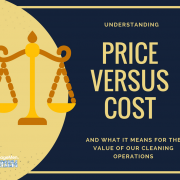How to Stop the Commoditization of Cleaning [HINT: It Starts with Purchasing]
When we first moved into our house, we went to a local big-box hardware store and purchased a lawn mower. We had just moved out of an apartment and had a lot of lawn maintenance equipment to buy, so we took the word of the salesperson at the store who told us that the cheaper lawn mower would work just fine for our needs. We didn’t do any research and made the decision completely on cost—and a recommendation from a stranger.
Well…. It turns out that wasn’t so smart because just last year, three years after purchasing that original lawn mower, we bought another lawn mower.
Have you ever heard the phrase “buy nice or buy twice”?
We also see this happening too often within cleaning operations. While a recent survey from Facility Cleaning Decisions shows that 62 percent of cleaning departments were safe from budget cuts in the past year, 56 percent of respondents said that the “lowest cost” was most important when purchasing products or equipment. And at no fault of cleaning managers, this is often a sad reality for many operations in our industry because cleaning isn’t looked at as a critical area in most businesses. When there’s little value for what we do, cost plays a key driver in many purchasing decisions.
But the initial cost of an item is much different than its price over its lifetime. Think about some of the potential implications associated with buying a poorly designed and/or “cheap” product:
- Higher cost of ownership: If you’re buying two lower-cost vacuums in the same period of time that you would use another higher-quality vacuum that costs a little more, you’re not saving money.
- Greater impact on employees: Better quality products often feature designs that make it easier and safer for employees to operate, such as being lighter or more ergonomically designed. They may also be less efficient, requiring employees to have to clean a surface more than once.
- Higher environmental cost: Higher quality items typically last longer, reducing the number of products headed to the landfill.
- Reduced employee morale: By not investing in equipment, you’re not investing in employees—and believe us, they take note.
- Business interruptions and headaches: A more cheaply made product may be more prone to break down. If other equipment isn’t available, it can result in a service disruption while repairs take place.
*****************
Recently, leaders from the ManageMen team had the opportunity to visit the research and development lab of a U.S. based manufacturer that supplies products to the cleaning industry. Filled with engineers, scientists and product designers, the space was something you’d imagine belonging to a high-tech firm in Silicon Valley—not a company developing equipment for the professional cleaning industry.
The environment was designed for creativity, innovation and collaboration. Techs wanted to know the common issues plaguing most cleaning departments and workers so they could design solutions to solve these issues. And the solutions they were creating were incredible — things that could truly change the way we clean our buildings while improving the safety and livelihood of the people performing that cleaning.
The issue is that many of the innovations never leave that lab. When product managers and salespeople have the opportunity to weigh in, they quickly squelch ideas, recognizing that the market won’t support it. Why? Because in most situations, the innovations will come with a high price tag. Developing innovative, products is only part of the equation. Many industry brands require that their products undergo rigorous performance and quality testing before they go to market, and all that testing comes at an expense.
We need to move beyond this cost-driven focus on purchasing. While cost will always play a factor, it should not be the only factor we consider when evaluating equipment and supplies. That mentality commoditizes our cleaning operations.
Instead, we need to think more about the overall PRICE of a product. We need to look at the price of that product over its lifetime—not just the upfront cost, but the cost we pay to make a phone call when it breaks down, the cost of the downtime when that unit is not in operation and the toil it takes on cleaning workers. These considerations, and many others, contribute to its overall price.
If we aren’t the first to put value in our cleaning operations, who will?

